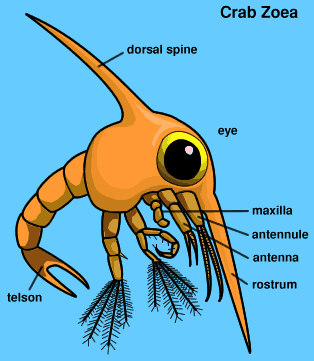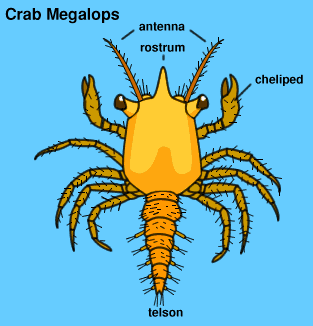HIGH OCTANE CRAB!EVIDENCE OIL DISPERSANT HAS ENTERED FOOD CHAIN!

SICK TO MY STOMACH, VOMITING. MASSIVE
HEADACHE. THE SHAKES! DOC, WHAT IS IT?http://www.huffingtonpost.com/2010/07/29/scientists-find-evidence_n_664298.html
Scientists have found signs of an oil-and-dispersant mix under the
shells of tiny blue crab larvae in the Gulf of Mexico, the first clear
indication that the unprecedented use of dispersants in the BP oil spill
has broken up the oil into toxic droplets so tiny that they can easily
enter the food chain.Marine biologists started finding orange blobs under the translucent
shells of crab larvae in May, and have continued to find them "in almost
all" of the larvae they collect, all the way from Grand Isle, Louisiana,
to Pensacola, Fla. -- more than 300 miles of coastline -- said Harriet
Perry, a biologist with the University of Southern Mississippi's Gulf
Coast Research Laboratory.And now, a team of researchers from Tulane University using infrared
spectrometry to determine the chemical makeup of the blobs has detected
the signature for Corexit, the dispersant BP used so widely in the
Deepwater Horizon"It does appear that there is a Corexit sort of fingerprint in the blob
samples that we ran," Erin Gray, a Tulane biologist, told the Huffington
Post Thursday. Two independent tests are being run to confirm those
findings, "so don't say that we're 100 percent sure yet," Gray said."The chemistry test is still not completely conclusive," said Tulane
biology professor Caz Taylor, the team's leader. "But that seems the
most likely thing."With BP's well possibly capped for good, and the surface slick
shrinking, some observers of the Gulf disaster are starting to let down
their guard, with some journalists even asking: Where is the oil?But the answer is clear: In part due to the1.8 million gallons of
dispersant that BP used, a lot of the estimated 200 million or more
gallons of oil that spewed out of the blown well remains under the
surface of the Gulf in plumes of tiny toxic droplets. And it's short-
and long-term effects could be profound.BP sprayed dispersant onto the surface of the slick and into the jet of
oil and gas as it erupted out of the wellhead a mile beneath the
surface. As a result, less oil reached the surface and the Gulf's
fragile coastline. But more remained under the surface.Fish, shrimp and crab larvae, which float around in the open seas, are
considered the most likely to die on account of
exposure to the subsea oil plumes. There are fears, for instance, that
an entire year's worth of bluefin tuna larvae may have
perished.But this latest discovery suggests that it's not just larvae at risk
from the subsurface droplets. It's also the animals that feed on
them."There are so many animals that eat those little larvae," said Robert J.
Diaz, a marine scientist at the College of William and
Mary.Oil itself is of course toxic, especially over long exposure. But some
scientists worry that the mixture of oil with dispersants
will actually prove more toxic, in part because of the still not
entirely understood ingredients of Corexit, and in part because
of the reduction in droplet size."Corexit is in the water column, just as we thought, and it is entering
the bodies of animals. And it's probably having a lethal
impact there," said Susan Shaw, director of the Marine Environmental
Research Institute. The dispersant, she said, is like " a
delivery system" for the oil.Although a large group of marine scientists meeting in late May reached
a consensus that the application of dispersants was a
legitimate element of the spill response, another group, organized by
Shaw, more recently concluded "that Corexit
dispersants, in combination with crude oil, pose grave health risks to
marine life and human health and threaten to deplete
critical niches in the Gulf food web that may never recover."One particular concern: "The properties that facilitate the movement of
dispersants through oil also make it easier for them to
move through cell walls, skin barriers, and membranes that protect vital
organs, underlying layers of skin, the surfaces of
eyes, mouths, and other structures."Perry told the Huffington Post that the small size of the droplets was
clearly a factor in how the oil made its way under the
crab larvae shells. Perry said the oil droplets in the water "are just
the right size that probably in the process of swimming or
respiring, they're brought into that cavity."That would not happen if the droplets were larger, she said.
The oil droplet washes off when the larvae molt, she said -- but that's
assuming they live that long. Larvae are a major food
source for fish and other blue crabs -- "their siblings are their
favorite meal," Perry explained. Fish are generally able to
excrete ingested oil, but inverterbrates such as crabs don't have that
ability.Perry said the discovery of the oil and dispersant blobs is very
troubling -- but not, she made clear, because it has any impact
on the safety of seafood in the short run. "Unlike heavy metals that
biomagnify as they go up the foodchain, oil doesn't seem
to do that," she said. Rather, she said, "we're looking at long-term
ecological effects of having this oil in contact with marine
organisms."Diaz, the marine scientist from William and Mary, spoke at a lunchtime
briefing about dispersants on Capitol Hill on
Thursday.Dispersant, he explained, "doesn't make the oil go away, it just puts it
from one part of the ecosystem into another."In this case, he said, "the decision was to keep as much of the oil
subsurface as possible." As a result, the immediate impact
on coastal wildlife was mitigated. But the effects on ocean life, he
said, are less clear -- in part because there's less known
about ocean ecosystems than coastal ones."As we go further offshore, as the oil industry has gone offshore, we
find that we know less," he said. "We haven't really been
using oceanic species to assess the risks, and this is a key issue."(Similar concerns have been expressed about the lack of important data
that would allow scientists to accurately assess the
effects of the spill on the Gulf's sea turtles, whose plight is emerging
as particularly poignant.)Diaz warned of the danger posed to bluefin tuna -- and also to "the
signature resident species in the Gulf, the shrimp." He
noted that all three species of Gulf shrimp spawn offshore before moving
back into shallow estuaries.Diaz also expressed concern that dispersed oil droplets could end up
doing great damage to the Gulf's many undersea coral
reefs. "If the droplets agglomerate with sediment," he said, "they could
even settle to the bottom."Nancy Kinner, co-director of the Coastal Response Center at the
University of New Hampshire, said the use of dispersants
in this spill raises many issues that scientists need to explore,
starting with the effects of long-term exposure. She also noted
that scientists have never studied the effects of dispersants when
they're injected directly into the turbulence of the plume, as
they were here, or at such depth, or at such low temperatures, or under
such pressure.She also said it will be essential for the federal government to
accurately determine how much oil made it out of the blown
well. A key data point for scientists is the ratio of dispersant to oil,
she said, and "if you don't know the flow rate of the oil,
you don't know what you dispersant-to-oil ratio is."After a series of ludicrous estimates, the federal government settled
last month on an official estimate of about 20,000 to
40,000 barrels a day, but BP is widely expected to contest that figure
and some scientists think it is still a low-ball estimate.There seems to be no doubt that history will record that the use of
dispersants was good for BP, making it harder to tell how
much oil was spilled, and reducing the short-term visible impact. But
what's less clear is whether it will turn out to have been
good for the Gulf.

GOOD FOR THE GULF? ARE YOU CRAZY? I
FEEL STONED! DIZZY! SWIMMING IN CIRCLES!
* * * * * * * * * * * * * * * * * * * * * * * * *
Our POSTER is ANITA SANDS HERNANDEZ, Los Angeles Writer, Researcher, mother of 4 and career Astrologer. Catch up with her websites TRUTHS GOV WILL HIDE & NEVER TELL YOU, also The FUTURE, WHAT'S COMIN' AT YA! FRUGAL LIFE STYLE TIPS, HOW TO SURVIVE the COMING GREAT DEPRESSION, and Secrets of Nature, HOLISTIC, AFFORDABLE HEALING. Also ARTISANRY FOR EXPORT, EARN EUROS...Anita is at astrology@earthlink.net ). Get a 35$ natal horoscope "my money/future life" reading now + copy horoscope as a Gif file graphic! No smarter, more accurate career reading out there!
<=== BACK TO TRACKING THE ECONOMY, an INDEX PAGE
<===BACK TO MONEY SECRETS ONLY THE EXPERTS KNOW
<=== BACK TO SECRETS THE GOV DOES NOT WANT YOU TO KNOW
<==== BACK TO THE WALL STREET MELTDOWN WEBSITE, with "WHAT TO DO TO SURVIVE" TIPS
<=== SHOW ME THE FIX for the USA/ WORLD, an INDEX PAGE.
<== SHOW ME THE HAPPY R)EVOLUTION PAGE
<=== BACK TO "GUERILLA CAPITALISM" -- THE SOLUTION!
<==== BACK TO THE "VITAL SIGNS OF A DYING ECONOMY" the "FUTURE" WEBPAGE
<=== BACK TO ENRON PLANET, the DOOMSDAY SCENARIO as all connected crooked CEOS do it now
<====BACK TO THE HOLISTIC GOURMET, BON MARCHE
<=== BACK TO THE GLEENERS PAGE
<=== BACK TO THE FRUGAL INDEX PAGE
<== BACK TO THE FUTURE INDEX PAGE
<=== BACK TO THE GENTLEMAN FARMER'S GARDEN INDEX
<=== INVESTIGATE DOING DRIP IRRIGATE- LINES in DROUGHT STATE GARDENS for big $. LEARN in 1 hr at HOME DEPOT
<--- BACK TO THE ACTIVISM IS A DELIGHT PAGE
<=== BACK TO THE MALTHUSIAN INDEX PAGE
<=== PORTAL to 7,000 FREE CLASSROOMS, SAVE TO CACHE, REPUBLISH FREE, ATTRACT AD REVENUE